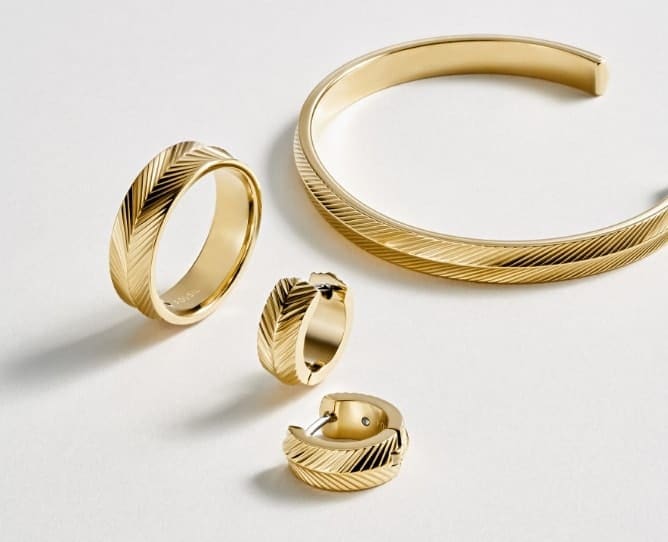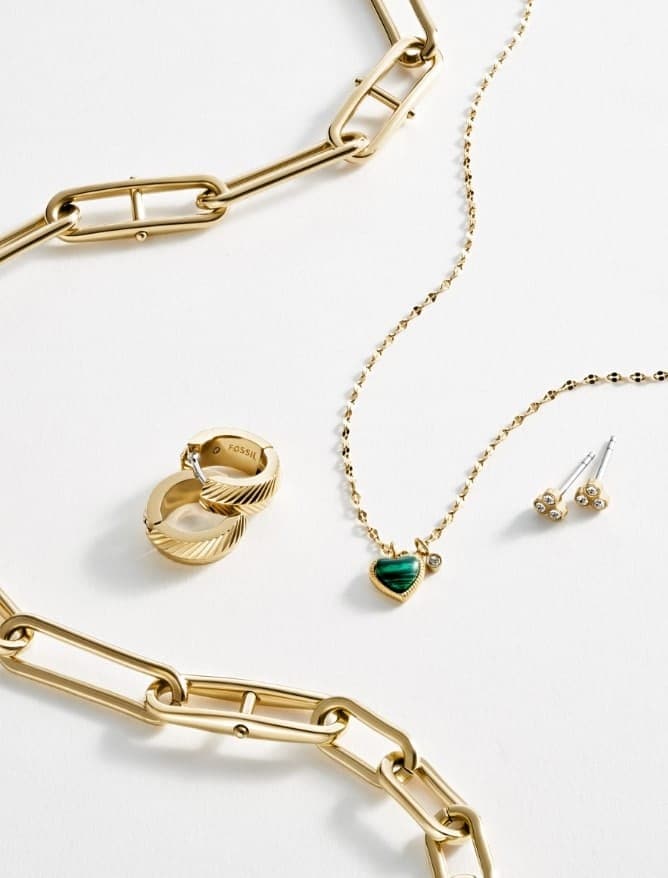null
Fossil Jewellery
Cleaning & Care
Fossil Jewellery Cleaning & Care

How To Clean Most Fossil Jewellery
Pour a small amount of mild soap into lukewarm water, and use a small, soft toothbrush to delicately clean your jewellery. Toothbrushes are ideal for cleaning jewellery with intricate details. This particular cleaning method should not be used to clean jewellery with cultured freshwater pearls (see below for more details).
How To Clean Freshwater Pearls & Gemstones
Wipe down your freshwater pearls or gemstones with a jewellery cleaning cloth to maintain lustre and avoid dirt buildup. If buildup occurs, use damp cloth to wipe and leave out to dry before storing them away.
How To Best Take Care of Fossil Jewellery
Fossil jewellery is made with natural semi-precious, glass or cubic zirconia stones, laboratory grown diamonds or synthetic materials in .925 sterling silver, stainless steel or brass in a special colour and finish. Precious metals such as sterling silver will achieve a patina when exposed to the elements over a period of time.
Fossil jewellery is made with natural semi-precious, glass or cubic zirconia stones, laboratory grown diamonds or synthetic materials in .925
sterling silver, stainless steel or brass in
a special colour and finish. Precious metals such as sterling silver will achieve a patina when
exposed to the elements over a period of time.
Jewellery Care Tips
Fossil Jewellery should be the last thing we put on in the morning, and the first thing we take off at night.
Apply any hairspray or perfume before putting on your jewellery.
Handle Fossil jewellery with care. Be extra careful not to drop them on the floor or knock them against hard surfaces as this could hurt their delicate structures.
Remove all Fossil jewellery prior to swimming, bathing and partaking in sports or other physical activity.
Use microfibre cloths or soft cleaning cloths to clean the jewellery.
Store in the provided jewellery pouch in a cool, dry place. Water, sunlight and exposure to chemicals or perspiration can cause discolouration and damage.

Material Guide: Get To Know Your Fossil Jewellery
Stainless Steel – Stainless steel is an alloy used for jewellery because of its durability and anti-erosion properties. It’s the metal of choice for many types of high-quality bracelets, earrings, necklaces and rings. Stainless steel can take a brushed or polished look and can be plated in a variety of colours. It is hypoallergenic and scratch resistant.
Sterling Silver – .925 sterling silver is a precious metal that contains 92.5% silver and is used for its high shine and hypoallergenic properties. Sterling silver can tarnish over time and requires polishing if not worn consistently.
Brass – Brass is an alloy mainly made of copper and zinc. The proportions of the copper and zinc can vary. It is known for its high tensile strength and durability for jewellery. It is not hypoallergenic and some people may be truly allergic to it. Electroplating will be applied on brass jewellery.
Mother-of-Pearl – Mother-of-pearl is a genuine material made from the inner lining of different shells. Each piece may have unique variations in colour.
Freshwater Pearl – A Freshwater Pearl is a cultured pearl that is farmed and created using freshwater mussels. It is genuine and comes in a range of colours and shapes. The most common type used in Fossil jewellery is the round, white freshwater pearl.
Cubic Zirconia – Cubic zirconia is a perfectly structured human-made stone that closely resembles diamond, it sparkles brighter than crystal glass and is more durable than most gems. Cubic zirconia may vary in colour, clarity and cut.
Semi-precious – Gemstones and/or semi-precious stones are used in select styles. A gemstone is a mineral crystal used for its lustre or physical properties.
Laboratory Grown Diamond – A laboratory grown diamond is a diamond seed that’s nurtured in an environment rich with carbon atoms. After being put through a process that breaks down its molecular bonds, the pure carbon begins to stick to the seed and a new diamond is formed, layer by layer. Upon completion of this process, the laboratory grown diamond is precision-cut by expert master cutters.
Gold Plated Brass – To create this material, a solid layer of gold is mechanically bonded to a base of brass. Heat and pressure are then used to bond the gold to the surface of the base metal. Standard cleaning instructions apply.
Gold Plated Sterling Silver – To create this material, a solid layer of gold is mechanically bonded to a base of sterling silver. Heat and pressure are then used to bond the gold to the surface of the base metal. Sterling silver cleaning instructions apply.
